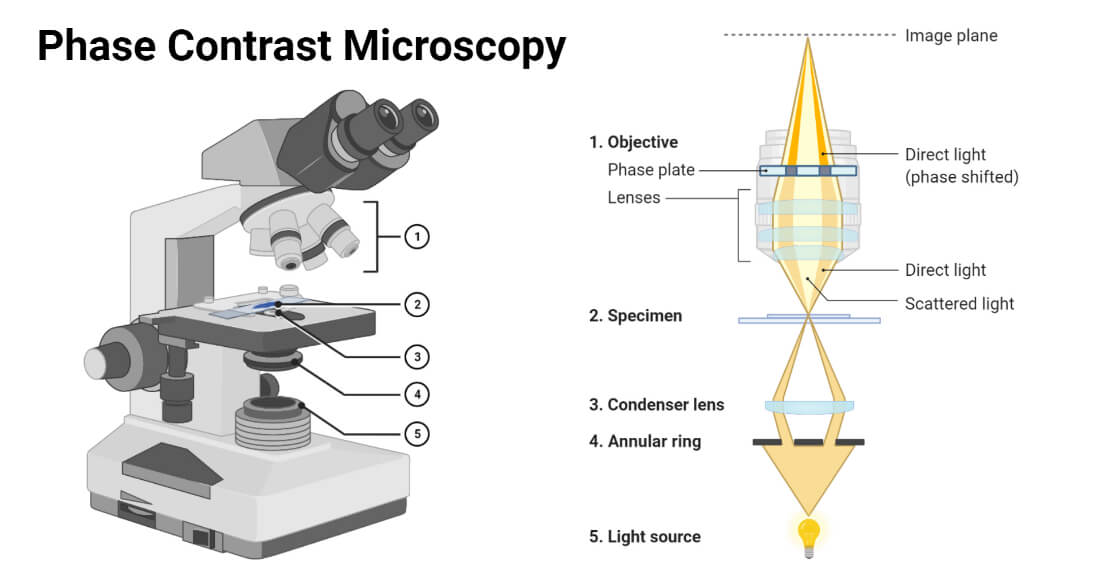Interesting Science Videos
What is Phase-contrast microscopy?
Unstained living cells absorb practically no light. Poor light absorption results in extremely small differences in the intensity distribution in the image. This makes the cells barely, or not at all, visible in a brightfield microscope. Phase-contrast microscopy is an optical microscopy technique that converts phase shifts in the light passing through a transparent specimen to brightness changes in the image. It was first described in 1934 by Dutch physicist Frits Zernike.
Principle of Phase contrast Microscopy

When light passes through cells, small phase shifts occur, which are invisible to the human eye. In a phase-contrast microscope, these phase shifts are converted into changes in amplitude, which can be observed as differences in image contrast.
The Working of Phase contrast Microscopy
- Partially coherent illumination produced by the tungsten-halogen lamp is directed through a collector lens and focused on a specialized annulus (labeled condenser annulus) positioned in the substage condenser front focal plane.
- Wavefronts passing through the annulus illuminate the specimen and either pass through undeviated or are diffracted and retarded in phase by structures and phase gradients present in the specimen.
- Undeviated and diffracted light collected by the objective is segregated at the rear focal plane by a phase plate and focused at the intermediate image plane to form the final phase-contrast image observed in the eyepieces.
Parts of Phase contrast Microscopy
Phase-contrast microscopy is basically a specially designed light microscope with all the basic parts in addition to which an annular phase plate and annular diaphragm are fitted.
The annular diaphragm
- It is situated below the condenser.
- It is made up of a circular disc having a circular annular groove.
- The light rays are allowed to pass through the annular groove.
- Through the annular groove of the annular diaphragm, the light rays fall on the specimen or object to be studied.
- At the back focal plane of the objective develops an image.
- The annular phase plate is placed at this back focal plane.
The phase plate
- It is either a negative phase plate having a thick circular area or a positive phase plate having a thin circular groove.
- This thick or thin area in the phase plate is called the conjugate area.
- The phase plate is a transparent disc.
- With the help of the annular diaphragm and the phase plate, the phase contrast is obtained in this microscope.
- This is obtained by separating the direct rays from the diffracted rays.
- The direct light rays pass through the annular groove whereas the diffracted light rays pass through the region outside the groove.
- Depending upon the different refractive indices of different cell components, the object to be studied shows a different degree of contrast in this microscope.
Applications of Phase contrast Microscopy
To produce high-contrast images of transparent specimens, such as
- living cells (usually in culture),
- microorganisms,
- thin tissue slices,
- lithographic patterns,
- fibers,
- latex dispersions,
- glass fragments, and
- subcellular particles (including nuclei and other organelles).
Applications of phase-contrast microscopy in biological research are numerous.
Advantages of Phase contrast Microscopy
- Living cells can be observed in their natural state without previous fixation or labeling.
- It makes a highly transparent object more visible.
- No special preparation of fixation or staining etc. is needed to study an object under a phase-contrast microscope which saves a lot of time.
- Examining intracellular components of living cells at relatively high resolution. eg: The dynamic motility of mitochondria, mitotic chromosomes & vacuoles.
- It made it possible for biologists to study living cells and how they proliferate through cell division.
- Phase-contrast optical components can be added to virtually any brightfield microscope, provided the specialized phase objectives conform to the tube length parameters, and the condenser will accept an annular phase ring of the correct size.
Limitations of Phase contrast Microscopy
- Phase-contrast condensers and objective lenses add considerable cost to a microscope, and so phase contrast is often not used in teaching labs except perhaps in classes in the health professions.
- To use phase-contrast the light path must be aligned.
- Generally, more light is needed for phase contrast than for corresponding bright-field viewing, since the technique is based on the diminishment of the brightness of most objects.
Reference
- https://en.wikipedia.org/wiki/Phase-contrast_microscopy
- https://www.microscopyu.com/techniques/phase-contrast/introduction-to-phase-contrast-microscopy
- https://ibidi.com/content/213-phase-contrast
- https://www.ruf.rice.edu/~bioslabs/methods/microscopy/phase.html
- https://www.microscopyu.com/techniques/phase-contrast/phase-contrast-microscope-configuration
- https://www.slideshare.net/manjunathasanka/phase-contrast-microscope-41441936
- http://www.biologydiscussion.com/botany/practicals-botany/parts-and-working-of-phase-contrast-microscope-botany/54531

Pdf available?